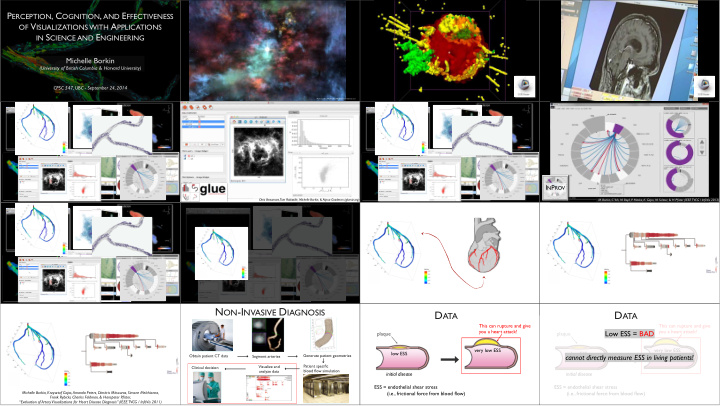



P ERCEPTION , C OGNITION , AND E FFECTIVENESS OF V ISUALIZATIONS WITH A PPLICATIONS IN S CIENCE AND E NGINEERING Michelle Borkin (University of British Columbia & Harvard University) CPSC 547, UBC - September 24, 2014 Movie Credits: NASA/CXC/MIT/D.Berry/T. Delaney et al. I N P ROV Chris Beaumont, Tom Robitaille, Michelle Borkin, & Alyssa Goodman (glueviz.org) M. Borkin, C. Yeh, M. Boyd, P. Macko, K. Gajos, M. Seltzer, & H. Pfister (IEEE TVCG / InfoVis 2013) N ON -I NVASIVE D IAGNOSIS D ATA D ATA This can rupture and give This can rupture and give you a heart attack! you a heart attack! Low ESS = BAD plaque plaque very low ESS very low ESS low ESS low ESS Obtain patient CT data Generate patient geometries cannot directly measure ESS in living patients! Segment arteries Patient specific Visualize and Clinical decision blood flow simulation analyze data initial disease initial disease ESS = endothelial shear stress ESS = endothelial shear stress Michelle Borkin, Krzysztof Gajos, Amanda Peters, Dimitris Mitsouras, Simone Melchionna, (i.e., frictional force from blood flow) (i.e., frictional force from blood flow) Frank Rybicki, Charles Feldman, & Hanspeter Pfister, “Evaluation of Artery Visualizations for Heart Disease Diagnosis” (IEEE TVCG / InfoVis 2011)
F ORMATIVE Q UALITATIVE S TUDY T ASK T AXONOMY T ASK T AXONOMY • Semi-structured interviews T ASK A BSTRACTION C LINICAL R ESEARCH T ASK A BSTRACTION C LINICAL R ESEARCH • 10 medical doctors and researchers “Identify regions of low ESS” find extrema X X • Brigham & Women’s Hospital (Boston, MA) Visualize and Clinical decision analyze data T ASK T AXONOMY T ASK T AXONOMY T ASK T AXONOMY T ASK T AXONOMY T ASK A BSTRACTION C LINICAL R ESEARCH T ASK A BSTRACTION C LINICAL R ESEARCH T ASK A BSTRACTION C LINICAL R ESEARCH T ASK A BSTRACTION C LINICAL R ESEARCH “Identify regions of low ESS” find extrema X X “Identify regions of low ESS” find extrema X X “Identify regions of low ESS” find extrema X X “Identify regions of low ESS” find extrema X X “Identify stenosis or blockage” find extrema X X “Identify stenosis or blockage” find extrema X X “Identify stenosis or blockage” find extrema X X “Identify stenosis or blockage” find extrema X X “View all ESS data for patterns” cluster X X “View all ESS data for patterns” cluster X X “View all ESS data for patterns” cluster X X “Study blood flow velocity patterns” find anomalies X “Study blood flow velocity patterns” find anomalies X “Identify regions of blood find anomalies X recirculation” T ASK T AXONOMY T ASK T AXONOMY T ASK T AXONOMY 3D VS . 2D T ASK A BSTRACTION T ASK A BSTRACTION T ASK A BSTRACTION C LINICAL R ESEARCH C LINICAL R ESEARCH C LINICAL R ESEARCH “Identify regions of low ESS” find extrema X X “Identify regions of low ESS” find extrema X X “Identify regions of low ESS” find extrema X X “Identify stenosis or blockage” find extrema X X “Identify stenosis or blockage” find extrema X X “Identify stenosis or blockage” find extrema X X “View all ESS data for patterns” cluster X X “View all ESS data for patterns” cluster X X “View all ESS data for patterns” cluster X X “Study blood flow velocity patterns” find anomalies X “Study blood flow velocity patterns” find anomalies X “Study blood flow velocity patterns” find anomalies X “Identify regions of blood “Identify regions of blood “Identify regions of blood find anomalies X find anomalies X find anomalies X recirculation” recirculation” recirculation” “Investigate other physical variables of “Investigate other physical variables of “Investigate other physical variables of find anomalies X find anomalies X find anomalies X blood flow” blood flow” blood flow” 3D VS . 2D L AYOUT AND P ROJECTIONS
C OLOR C OLOR C OLOR Preferred Too “radiological” (standard) Non-rainbow favorite! Q UANTITATIVE S TUDY : G OALS Q UANTITATIVE S TUDY Q UANTITATIVE S TUDY • Dependent measures: • 21 Harvard Medical students (12 women and 9 men) 3D vs. 2D rainbow vs. diverging • Mixed within-subject and between-subject design: ‣ fraction of low ESS regions identified ‣ number of false positives (i.e., non-low ESS regions ‣ within = dimensionality of representation (2D or 3D) identified as low ESS) ‣ between = color mapping (rainbow or diverging) ‣ time to complete a diagnosis e.g., Participant A e.g., Participant B Q UANTITATIVE S TUDY Q UANTITATIVE S TUDY Q UANTITATIVE S TUDY Q UANTITATIVE S TUDY
A CCURACY A CCURACY E FFICIENCY Strong effect of dimensionality on accuracy Strong effect of dimensionality on accuracy Participants more efficient in 2D . ...as well as color 5.6 sec/region 2.4 sec/region 39% 62% 39% 91% R ESULTS How many low ESS How many low ESS regions found? regions found? E FFICIENCY E FFICIENCY C OMPLEXITY C OMPLEXITY Participants more efficient in 2D . Participants more efficient in 2D . Accuracy decreases with increased data complexity in 3D Accuracy decreases with increased data complexity in 3D Rainbow color map has greater effect on efficiency in 3D. (not true in 2D!) participants less accurate 5.6 sec/region 10.2 sec/region 2.6 sec/region 2.6 sec/region F INDINGS S UMMARY F INAL R EMARKS • Even for 3D spatial data, a 2D representation is M ICHELLE B ORKIN • 3D representation is still essential ‣ more accurate for spatial tasks http://bit.ly/mborkin for surgical planning ‣ more efficient for spatial tasks @michelle_borkin • Rainbow color map • 2D tree diagram applicable to ! ‣ is not accurate and not efficient borkin@cs.ubc.ca other applications ‣ has adverse effects even greater in 3D Research funded through the NDSEG (National Defense Science and Engineering Graduate) Fellowship Program, and the NSF Graduate Research Fellowship Program.
Recommend
More recommend